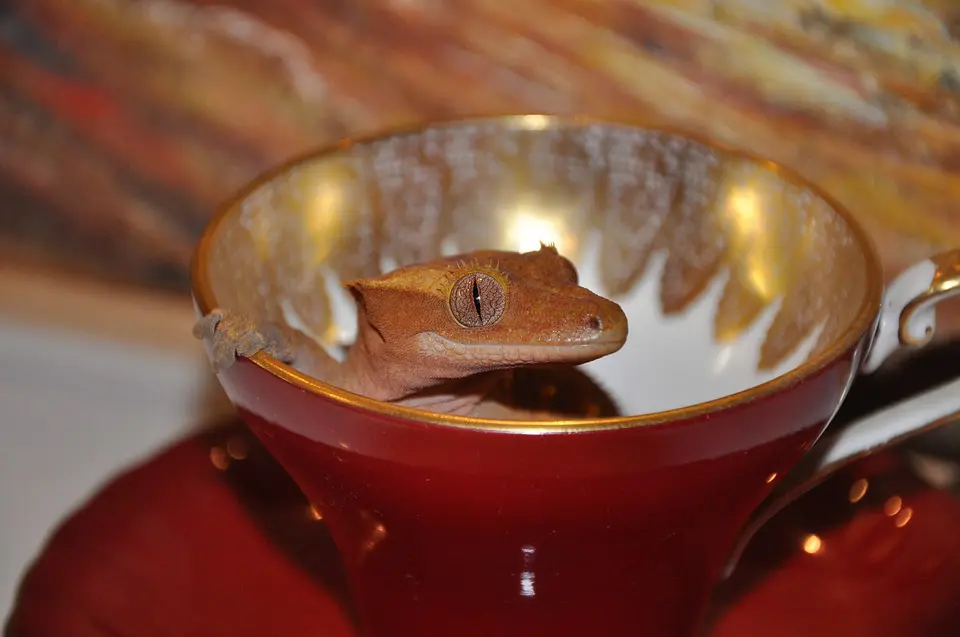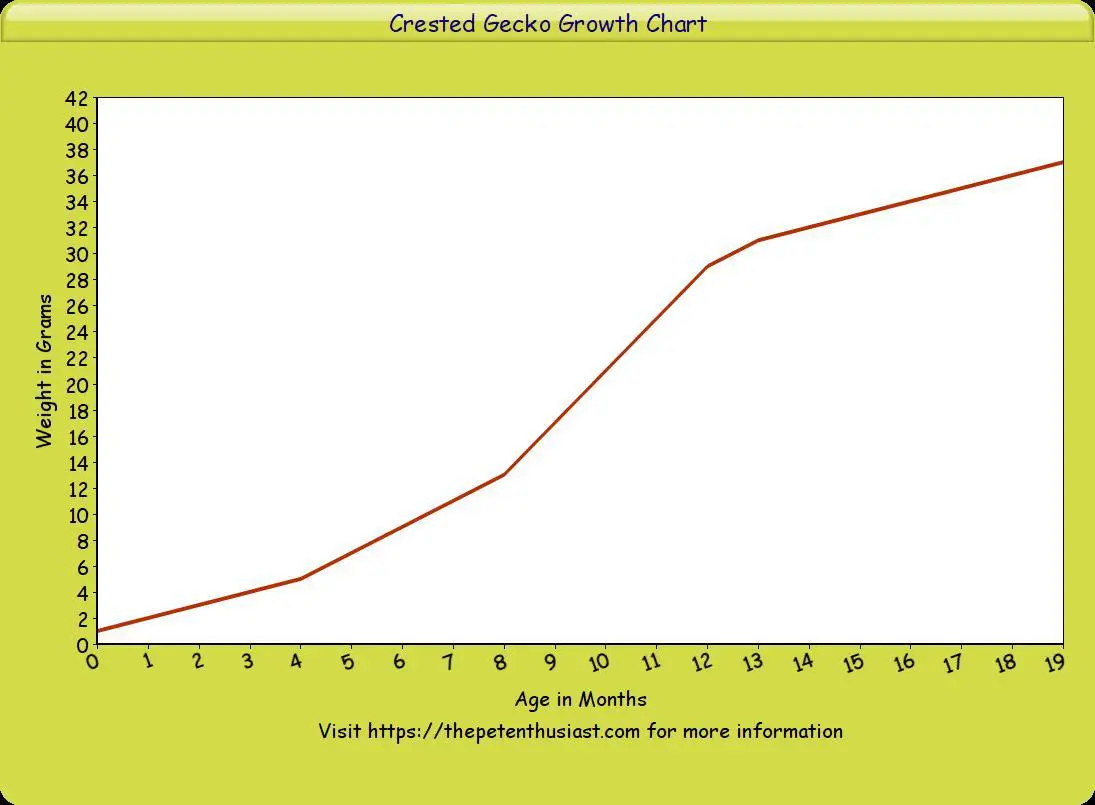Crested geckos are small lizards, but you may be wondering how big will your crestie get. Wondering the weight they will grow to and how you can improve their health to ensure healthy growth?
There are so many questions when considering to welcome a reptilian pet into your home, size, and space they will need is one of them.
Continue reading below for more information on crested gecko growth chart, how is a crested gecko growth rate from hatching to adult.
Table of Contents
How To Measure A Crested Gecko Weight?
Now if your crested gecko is used to being handled, chances are you aren’t going to be able to get him or her to sit still while you weigh them.
There are a couple of easy ways that reptile owners have tried to get the accurate weight of their gecko.
- Take a cup or bowl, once weighed you can allow your gecko to climb inside and then weigh it again. Take the weight with the gecko off the original weight of the cup or bowl.
- Using a Tupperware container with a lid, allow your gecko to climb inside. Close the lid gently to stop the crestie from escaping while you weigh them. Do not seal the lid, ensure you allow ample airflow.

Crested Gecko Growth Chart
To get an idea on the age or weight your crested gecko should be, here is an approximate growth chart you can use.

|
Age | Weight |
|---|---|
|
1 month | 2 grams |
| 2 months |
3 grams |
|
3 months | 4 grams |
| 4 months |
5 grams |
|
5 months | 7 grams |
| 6 months |
9 grams |
|
7 months | 11 grams |
| 8 months |
13 grams |
|
9 months | 17 grams |
| 10 months |
21 grams |
|
11 months | 25 grams |
| 12 months |
29 grams |
|
13 months | 31 grams |
| 14 months |
32 grams |
|
15 months | 33 grams |
| 16 – 24 months |
34 – 55 grams |
When is a crested gecko a baby?
Crested geckos are considered babies until they reach the age of six months or eight grams in weight.
When is a crested gecko a juvenile?
Juveniles are from six months to eighteen months. At this point, they are considered adults.
When is a crested gecko fully grown?
A crested gecko is considered fully grown once it reaches adult size, which is at about eighteen months of age.
How long does it take for a crested gecko to grow?
It takes these geckos two years to grow to their full adult size.
When do they grow fast?
A crested gecko grows the most as a juvenile. They can grow twenty grams in six months.
Of course, this is determined by the habitat and diet that you have in place for your gecko.
When do they stop growing?
Crested geckos stop growing at adult size, which is eighteen months.
Average weight of a full-grown crested gecko
- Fully grown male crested geckos – 25 grams
- Fully grown female crested geckos – 35 to 55 grams
When is a crested gecko considered underweight?
On average a healthy crested gecko will gain approximately one gram of weight per month. They should have a rounded tail.
While babies and younger geckos will show some ribs, more than the adults, you need to ensure your gecko isn’t bony. As they age, the gecko will get more rounded.
If the ribs are sticking out as an adult, then it is possible that your gecko could be underweight.
When is a crested gecko considered overweight?
When a crested gecko is on the overweight side, they tend to have chubby legs. As they bend you will see little fat rolls.
While it may look cute and you think your gecko is healthy because they are plump, it is not healthy for these reptiles to get overweight.
Crested Gecko Development Stages
When do they start the first shedding?
Baby crested geckos grow fast and should shed within the first few days.
- Babies should shed every week
- Juveniles should shed every second week
- Adults should be shedding every two to four weeks.
When do they start first brumation?
Brumation, which is a type of reptilian hibernation, happens during the winter months when the temperatures drop.
Baby and juvenile crested geckos should not be allowed to brumate. They should only start brumation in their adult years.
When can I tell if a crested gecko is a male or female?
It is very difficult to accurately sex your crested gecko until it is at least three to four months of age. When they reach their adult years, they are much easier to sex.
Males have external hemipenal bulges that are near the tail and the preanal pores are found right in front of the vent.
When are they ready for mating/breeding?
Male and female crested geckos are ready to start mating at around nine months when they reach sexual maturity.
While they can breed at this age, in captivity it’s recommended to wait until they are fully grown, which should be around one to two years of age.
Factors That Impact Growth Rate
Taking ownership of a crested gecko means you take full responsibility for its care and health in captivity.
Of course, you want to ensure your gecko grows strong and healthy, reaching full adult size with ease.
Here are a few things that can impact the growth rate of crested geckos.
Diet
Some crested gecko owners tend to feed their baby and juvenile geckos with baby food and crickets to help them reach sexual maturity by one year of age.
Of course, this isn’t the healthiest solution for your gecko, as the additional sugar can result in your gecko becoming overweight or obese.
When geckos are forced to grow too quickly, they don’t get the nutrients they need to grow strong and healthy, which can result in numerous health issues, including Metabolic Bone Disease.
Feeding a crested gecko will ensure your gecko reaches adulthood by two years in the safest and healthiest way.
Temperature and Humidity Levels
Your crested gecko’s growth rate will be affected when you have your temperature and/or humidity levels too low.
Low temperatures can result in digestive, immunity, and energy disorders. It will impact the appetite and overall health of your gecko in the long run.
Ambient temperatures should be between 71ºF and 79ºF. If you allow it to get too cold, your crestie will brumate and its growth will be slowed.
Humidity plays just as a vital role in the overall growth and health of your gecko.
High humidity can result in bacterial and fungal growth, negatively affecting your cresties health.
Humidity should be 70% and can drop to 50% for a few hours daily, which helps to avoid bacterial and fungal growth.
Humidity can be boosted by adding a shallow water bowl, misting regularly, choosing a moisture-holding substrate, or using a crested gecko waterfall.
Enclosure Size
Many new reptile owners make the mistake of thinking that if they use a larger enclosure their gecko will grow bigger and if they use a small enclosure, they can stunt the growth. This is not true.
The enclosure size can determine the growth rate of your gecko.
Placing a small gecko in a large enclosure will reduce the speed of growth, while if you place the same small gecko in a smaller enclosure, you will find they will grow faster. Why?
Basically, a small crested gecko grows faster in a smaller enclosure because they can find food and water with ease, without getting stressed.
It’s recommended to keep your gecko in a 15 gallon enclosure until they are around 20grams in weight, you can then move them to a 15 to 30 gallon.
They will need a larger enclosure once adults. If your enclosure is too large, consider adding two feeding spots, this makes it easier for your gecko to find food to fuel its growth.
Changes to Habitat and Diet
Most geckos are not going to eat when they move into a new enclosure and are settling down.
This acclimation period can last up to two weeks and can affect your gecko’s growth in this short time.
Avoid handling your gecko to help them get used to their new enclosure first.
Clean it once a week and start handling once they start eating and have settled down.
When you first bring your crested gecko home, you may find their growth rate changes.
This is because the breeder will feed different food to what you are feeding, this change in diet can result in a slowdown of growth rate.
Genetics
The size of the crested gecko’s parents along their growth history will play a role in the development of your own crested gecko.
This is why it’s recommended to keep a record of the growth rate of your gecko, which can help you identify the growth rate of their offspring, should you decide to breed in the future.
Parasites
If your crested gecko has parasites then it may slow or stop its growth as a result. A parasite infestation can cause serious health issues which can slow growth.
Keep an eye on your crested gecko poop to see if any parasites are present.
If your gecko isn’t growing and you’ve tried everything else, then it may be worthwhile letting the vet examine a fecal sample to identify if parasites are present or not.
Bullied in the Enclosure
If you have more than one crested gecko in an enclosure and one of them has slowed growth, it is possible that it is being bullied by the other gecko/s in the enclosure.
This is very common in small geckos.
Do not keep two male crested geckos together.
Choosing to house babies or juveniles together can also result in a slowed growth rate.
When a gecko is bullied it slows down on eating due to stress.
Keep baby geckos separately to boost confidence, appetite, and growth rate.